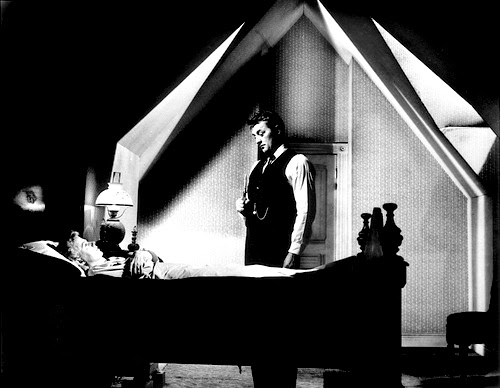Film Noir
 |
| Night of the Hunter |
Hollywood’s happy-go-lucky westerns and musicals were seemingly replaced overnight by a steady supply of dark films in which down-on-their-luck men and women struggled for their lives, loves, and the pursuit of happiness. Perhaps the most striking difference between pre- and post-war American cinema was that these struggles often ended in failure.
Film noir can be translated as ‘dark cinema’ though it literally means ‘black cinema.’ These films are distinguished visually by a strong reliance upon chiaroscuro lighting as well as unbalanced frame compositions and dramatically by characters with consistently poor decision making skills. Most noir films were low budget productions, though there were several major Hollywood features with that are exemplary for the classic period of film noir. (Almost all films made after 1960 are considered neo-noir, another subgenre that would require a separate blog entry to discuss.)
 |
| Kiss Me Deadly |
For my money, many of the best noir films are the ones that have placed an emphasis on dark and twisted tales of romance. Here are a few of my favorites noirs with an emphasis on tangled affairs of the heart:
Gilda (directed by Charles Vidor; starring Rita Hayworth, George Macready, and Glenn Ford)
Gilda tells the story of down-on-his-luck gambler Johnny Farrell (Ford) who begins working for German casino owner Ballin Mundson (Macready) in Buenos Aires during the height of the Second World War. The story becomes complicated once Mundson returns from a business trip with his new bride, Gilda (Hayworth), and it is immediately obvious that Farrell and Gilda have a shared past as well as a vicious hatred for each other. At this point, the film turns into something of a sado-masochistic love triangle -- a highly unusual concept for a major Hollywood production. This will always be the film for which Rita Hayworth is best remembered due to several iconic moments including her famous “striptease” performance of ‘Put the Blame on Mame.’ It is one of my favorite films and one of the best introductions to film noir.
Naked Kiss (directed by Samuel Fuller; starring Constance Towers)
Legendary filmmaker Samuel Fuller had a penchant for peeling back the outer layers of the American dream to reveal the hidden wounds that mar the American landscape. Fuller was most famous for films such as Pickup on South Street and Forty Guns as well as his use of a starter pistol to declare “Action!” when behind the camera. In Naked Kiss, Constance Towers plays a call girl that starts her life anew in a small town. She finds work as a nurse for children with disabilities in a hospital and soon falls in love with the town’s most eligible bachelor. Of course things are not quite as they seem in this town and Kelly finds that the love of her life has a dark and twisted history of his own.
Gun Crazy (directed Joseph H. Lewis; starring John Dall and Peggy Cummins)
A gun-obsessed Army sniper named Barton Tare (Dall) returns home from the war and falls in love with a carnival worker named Annie Starr (Cummins) who performs in an Annie Oakley-styled sharpshooting show. Their mutual love for guns leads to a violent encounter with Annie's former flame and soon spirals into an out of control crime spree. The film features one of the greatest single-take bank robbery sequences of all time (see clip below) as well as some unusually suggestive gunplay. Worth viewing.
Out of the Past (directed by Jacque Tourneur; starring Robert Mitchum, Kirk Douglas, and Jane Greer)
This was one of Robert Mitchum's best performances and features the actor as a private detective named Jeff who is hired to track down Kathie (Greer) the mistress of a high level gangster (Douglas). Kathie has run off to Mexico with $40,000 that belongs her former lover and has a habit of leaving a trail of dead men in her wake. This is a film that has everything you could ask for in a film noir - double and triple crosses, a true noir femme fatale, a snide crime boss with charming henchman, and a hero that has found himself caught in a mire of greed and lust.
All of the above films are available through the library catalog; however, if film noir piques an interest in you there are many more great films available through the library, Netflix, and Hulu. Some great film noir titles to take a look at include: Pickup on South Street, Phenix City Story, Night of the Hunter, The Big Heat, Kiss Me Deadly, The Third Man, Kiss of Death, Rififi, and The Devil Thumbs A Ride.
Comments